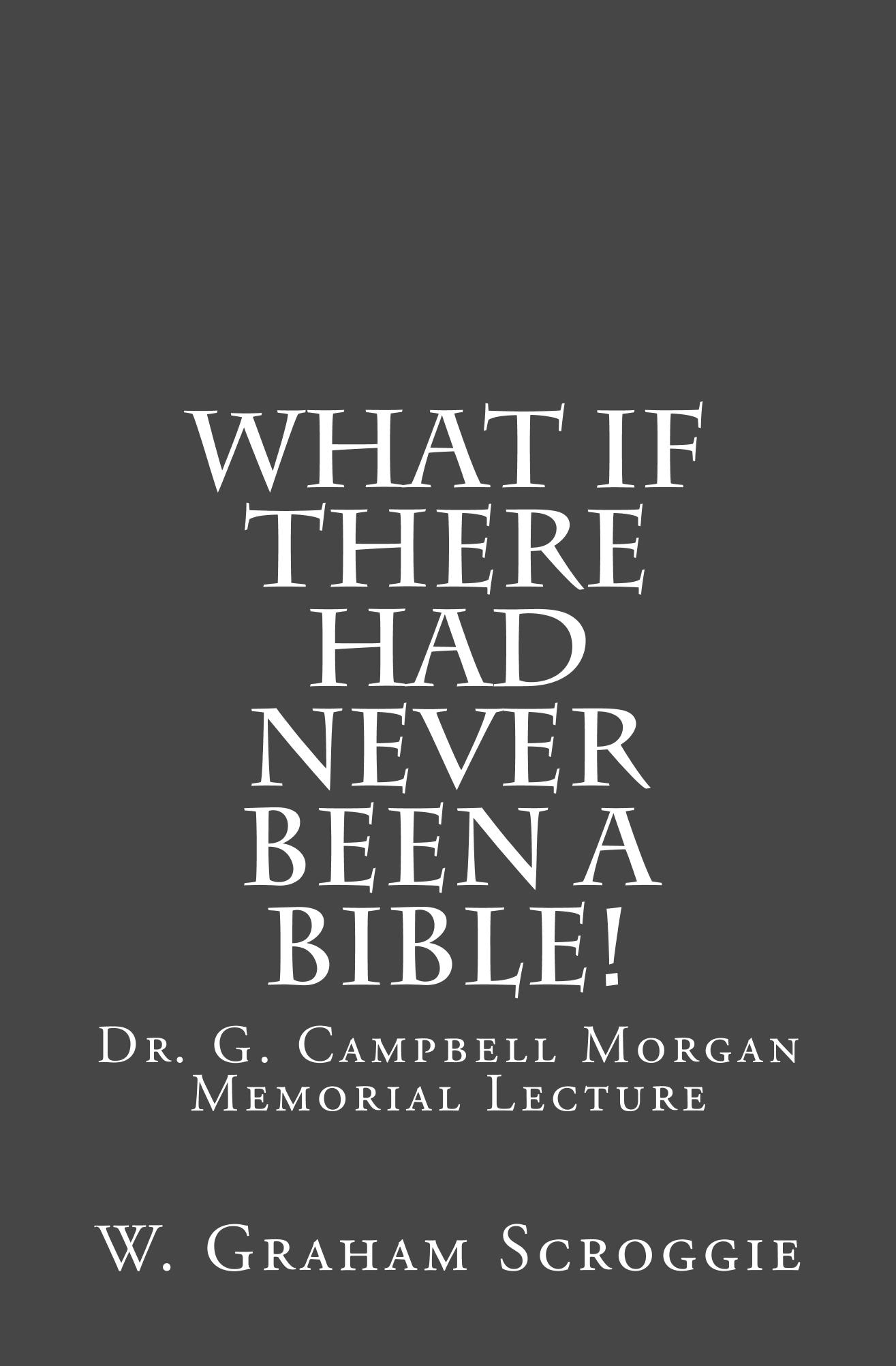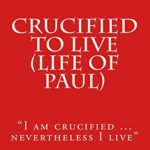Description
THE CAMPBELL MORGAN
BIBLE LECTURESHIP
WHAT IF THERE HAD NEVER BEEN A BIBLE!
G. CAMPBELL MORGAN
MEMORIAL LECTURE
(No. 2)
at
Westminster Chapel
WEDNESDAY. JUNE 14th, 1950
BY
W. GRAHAM SCROGGIE
D.D.
2016
Contents
What If There Had Never Been A Bible! 3
I. THE INFLUENCE OF THE BIBLE ON ART 7
II. THE INFLUENCE OF THE BIBLE ON MUSIC 9
III. THE INFLUENCE OF THE BIBLE ON LANGUAGE AND LITERATURE 13
IV. THE INFLUENCE OF THE BIBLE ON BELIEF 19
V. THE INFLUENCE OF THE BIBLE ON SOCIAL REFORM 21
VI. THE INFLUENCE OF THE BIBLE ON PREACHING AND REVIVALS 23
VII. THE INFLUENCE OF THE BIBLE ON THE MISSIONARY ENTERPRISE 30
VIII. THE INFLUENCE OF THE BIBLE ON THE INDIVIDUAL SOUL 33
IX. THE INFLUENCE OF THE BIBLE ON HOME LIFE 39
What If There Had Never Been A Bible!
When the Trustees who have instituted this Lectureship invited me to deliver the second Lecture, I could not and did not hesitate to comply with their wish. I am deeply sensible of the honour they have done me, and grateful for the opportunity to identify myself with their intention, in concrete ways, to perpetuate the memory of one who, on both sides of the Atlantic, exercised a unique ministry, by voice and by pen, in popularizing interest in and knowledge of the Holy Bible.
The Christian public of London was greatly privileged to have the opportunity for so many years of listening to the preaching and teaching of George Campbell Morgan, and I am confident that the time will never come when Westminster Chapel will cease to be a centre of Biblical instruction and inspiration to all who desire these blessings.
The subject I have chosen for your consideration is in some sense novel, but of the utmost importance for a true apprehension and adequate appreciation of the incomparable and inestimable value of those Sacred Scriptures which we call The Bible.
I begin by assuming that but for the Bible Christianity would not have survived. The Bible is the record of a divine revelation, and if there had been no record, no one, after the apostolic age, would have had any means of knowing what that revelation was. Oral tradition would have become more and more corrupt by omissions, additions, and other influences, until, finally, the truth would have been altogether lost.
This observation relates to the recorded New Testament revelation, but it must be evident that except for the Old Testament Writings the entire background of the New Testament revelation would never have been known, for Judaism had misread its own history.
The Biblical record is not the original revelation, but, had there been no record, we would never have known what the revelation had been, or, indeed, that there had been a revelation.
Christians do not worship the Bible, but the God who therein is revealed, but we do realize, or we ought to, that the Bible which makes the redeeming God known to us is, beyond all estimate, our most precious heritage.
Our present task is to try to envisage the obliteration of the Bible, and all traces of it, in our history, literature, art, music, language, social institutions, worship, service, and individual life.
I cannot hope, within the limits imposed by this lectureship, to succeed in so ambitious a task, but perhaps I may start a line of thought which will lead us to renewed thankfulness to God for having given to us such a book as the Bible, and thankfulness also for all who have diligently studied it, and faithfully expounded it.
I do not claim originality for the idea of the obliteration of the Bible, for in a book with the title The Eclipse of Faith, which was published anonymously in the middle of the nineteenth century, but was written by a Henry Rogers, there is a chapter called, The Blank Bible.
It tells of a dream a man had, that, on turning to read his Bible, as was his custom, he found only blank pages. On inquiry, he learned that all the Bibles in his neighborhood were also blanks, and all copies also in the book shops.
Some people, who never looked at the Bible while they had it, became interested in it now that it was lost.
One man who had never read it, said that it was “confounded hard to be deprived of his religion in his old age.” Another person greatly mourned the loss of her Bible, because in it, for greater safety, she had deposited £100 in notes, and these, too, had become blanks. All the Bibles in the land were blanks, and the volumes were being sold for day-books and ledgers; and instead of Isaiah, and our Lord’s parables, there were orders for silks and satins, cheese and bacon.
Then a movement was set afoot to re-write the Bible from the memories of those who had read and studied it.
A Trinitarian differed from a Unitarian over a critical recension. An Episcopalian did not agree with a Presbyterian that the words bishop and presbyter were interchangeable. A Calvinist had a vivid recollection of Romans 9, and an Arminian had some doubts about some of Paul’s sentiments. Husbands remembered what was due from their wives. Undertakers remembered it had been said that there was “a time to mourn.” A comedian recalled that it was said there was “a time to laugh.” Some young ladies remembered that there was “a time to love,” and everybody knew there was “a time to speak,” except a Quaker who thought that there was “a time to keep silence.”
Protestants and Papists disagreed about many passages, and some infidels thought that the visitation on the Bible was a great mercy, removing a book which promoted idolatry.
This dream begins to show what consternation and confusion would result from the obliteration of the Bible, but the subject can be indefinitely expanded.
Of course, the major disaster would be the loss of the Bible itself, but that would involve so many other losses, the contemplation of which must make the mind to reel, and the heart to faint.
Let us, then, consider some of the influences which this Book has exercised, which would have had no being had there been no Bible.
I. THE INFLUENCE OF THE BIBLE ON ART
By Art, more is meant than at first may be thought, for it includes architecture, sculpture, symbolism, painting, mosaics, monograms, frescoes, stained glass windows, and decorated manuscripts, and on all these Christianity has left its imprint.
In Architecture, from the basilicas of the time of Constantine to the magnificent cathedrals of our own time and country, the Christian idea and ideal have stood in marked contrast to the pagan temples of the ancient Greeks. Although it has been said that the devil invented Gothic architecture to prevent the people from hearing the Gospel, yet, expressive as it is of sacrifice, aspiration, peace, unity, and beauty, it is the embodiment of Christian ideals, and to multitudes has been an aid to Christian worship. Christian architecture, as Forsyth has said, “is stone made spiritual and musical,” it is “symphony in stone.”
As to Christian Symbolism, it is almost contemporary with the Christian era, appearing before the end of the first century. The favourite symbols have been the Fish, representing the fulness of Christ’s divinity; the Dove, representing peace; the Ship, representing the Church; the Anchor, representing hope; the Good Shepherd, and the Lamb of God. All these, as early as the second century, have been found in the catacombs of Rome.
But later, and down to our time, the influence of the Bible on Painting is seen in a very large number of masterpieces. As examples, one need only mention the Madonnas of Rubens, Raphael, Michelangelo, and of others; Rembrandt’s great works on The Supper at Emmaus, Christ before Pilate, The Descent from the Cross, and many more; Raphael’s Transfiguration; Botticelli’s Adoration of the Magi; Tintoretto’s The Marriage Feast; Leonardo da Vinci’s The Last Supper; Guido’s Ecce Homo; The Presentation in the Temple, and Mary Magdalene by Titian; Correggio’s Assumption of the Virgin, and The Crucifixion by Van Dyck, Velasquez, and Fra Angelico; and the more modern religious studies by Millais, Hole, Holman Hunt, Millet, G. F. Watts, Burne-Jones, Gabriel Rossetti; and Tissot’s 350 water-colour drawings on New Testament subjects.
But for the Bible these works would never have existed, and Art Galleries in London, and Dresden, and Florence, and Venice, and Paris, and Antwerp, and Milan would never have housed these great creations of Christian Art. It is not too much to say that some of the finest work that has ever been done by pen, and brush, and chisel, and trowel, has been done in the presentation of themes and scenes which only the Bible can supply.





Reviews
There are no reviews yet.